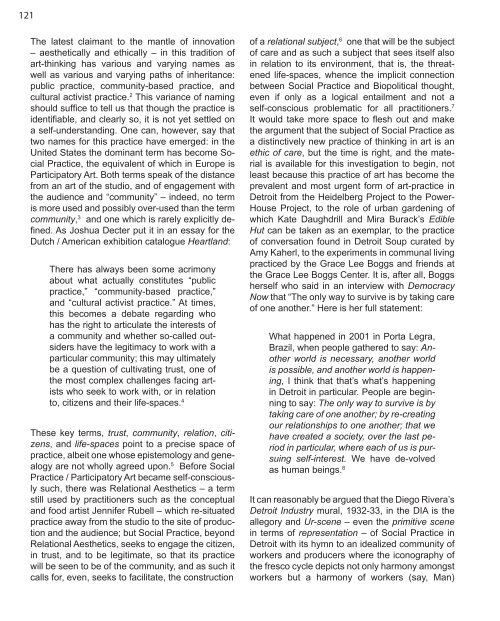Detroit Research Volume 1
You also want an ePaper? Increase the reach of your titles
YUMPU automatically turns print PDFs into web optimized ePapers that Google loves.
121<br />
The latest claimant to the mantle of innovation<br />
– aesthetically and ethically – in this tradition of<br />
art-thinking has various and varying names as<br />
well as various and varying paths of inheritance:<br />
public practice, community-based practice, and<br />
cultural activist practice. 2 This variance of naming<br />
should suffice to tell us that though the practice is<br />
identifiable, and clearly so, it is not yet settled on<br />
a self-understanding. One can, however, say that<br />
two names for this practice have emerged: in the<br />
United States the dominant term has become Social<br />
Practice, the equivalent of which in Europe is<br />
Participatory Art. Both terms speak of the distance<br />
from an art of the studio, and of engagement with<br />
the audience and “community” – indeed, no term<br />
is more used and possibly over-used than the term<br />
community, 3 and one which is rarely explicitly defined.<br />
As Joshua Decter put it in an essay for the<br />
Dutch / American exhibition catalogue Heartland:<br />
There has always been some acrimony<br />
about what actually constitutes “public<br />
practice,” “community-based practice,”<br />
and “cultural activist practice.” At times,<br />
this becomes a debate regarding who<br />
has the right to articulate the interests of<br />
a community and whether so-called outsiders<br />
have the legitimacy to work with a<br />
particular community; this may ultimately<br />
be a question of cultivating trust, one of<br />
the most complex challenges facing artists<br />
who seek to work with, or in relation<br />
to, citizens and their life-spaces. 4<br />
These key terms, trust, community, relation, citizens,<br />
and life-spaces point to a precise space of<br />
practice, albeit one whose epistemology and genealogy<br />
are not wholly agreed upon. 5 Before Social<br />
Practice / Participatory Art became self-consciously<br />
such, there was Relational Aesthetics – a term<br />
still used by practitioners such as the conceptual<br />
and food artist Jennifer Rubell – which re-situated<br />
practice away from the studio to the site of production<br />
and the audience; but Social Practice, beyond<br />
Relational Aesthetics, seeks to engage the citizen,<br />
in trust, and to be legitimate, so that its practice<br />
will be seen to be of the community, and as such it<br />
calls for, even, seeks to facilitate, the construction<br />
of a relational subject, 6 one that will be the subject<br />
of care and as such a subject that sees itself also<br />
in relation to its environment, that is, the threatened<br />
life-spaces, whence the implicit connection<br />
between Social Practice and Biopolitical thought,<br />
even if only as a logical entailment and not a<br />
self-conscious problematic for all practitioners. 7<br />
It would take more space to flesh out and make<br />
the argument that the subject of Social Practice as<br />
a distinctively new practice of thinking in art is an<br />
ethic of care, but the time is right, and the material<br />
is available for this investigation to begin, not<br />
least because this practice of art has become the<br />
prevalent and most urgent form of art-practice in<br />
<strong>Detroit</strong> from the Heidelberg Project to the Power-<br />
House Project, to the role of urban gardening of<br />
which Kate Daughdrill and Mira Burack’s Edible<br />
Hut can be taken as an exemplar, to the practice<br />
of conversation found in <strong>Detroit</strong> Soup curated by<br />
Amy Kaherl, to the experiments in communal living<br />
practiced by the Grace Lee Boggs and friends at<br />
the Grace Lee Boggs Center. It is, after all, Boggs<br />
herself who said in an interview with Democracy<br />
Now that “The only way to survive is by taking care<br />
of one another.” Here is her full statement:<br />
What happened in 2001 in Porta Legra,<br />
Brazil, when people gathered to say: Another<br />
world is necessary, another world<br />
is possible, and another world is happening,<br />
I think that that’s what’s happening<br />
in <strong>Detroit</strong> in particular. People are beginning<br />
to say: The only way to survive is by<br />
taking care of one another; by re-creating<br />
our relationships to one another; that we<br />
have created a society, over the last period<br />
in particular, where each of us is pursuing<br />
self-interest. We have de-volved<br />
as human beings. 8<br />
It can reasonably be argued that the Diego Rivera’s<br />
<strong>Detroit</strong> Industry mural, 1932-33, in the DIA is the<br />
allegory and Ur-scene – even the primitive scene<br />
in terms of representation – of Social Practice in<br />
<strong>Detroit</strong> with its hymn to an idealized community of<br />
workers and producers where the iconography of<br />
the fresco cycle depicts not only harmony amongst<br />
workers but a harmony of workers (say, Man)





